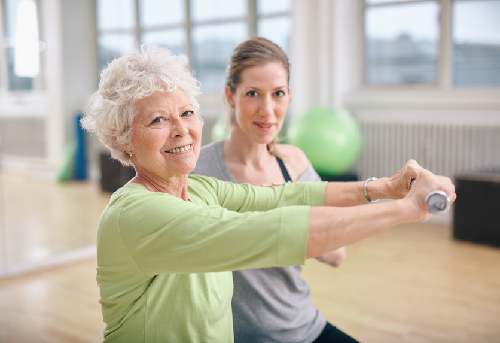 If I were to ask you about exercise, what would come to mind? I’d bet it would be things like walking, jogging, cycling, hitting the treadmill, swimming, or other activities that get your heart pumping.
If I were to ask you about exercise, what would come to mind? I’d bet it would be things like walking, jogging, cycling, hitting the treadmill, swimming, or other activities that get your heart pumping.
And you’d be totally right. All of those activities are great forms of cardiovascular exercise that can help improve heart health, lower blood pressure, and reduce the risk of all kinds of diseases.
The value of strength training, however, is often overlooked. Once you hit 50, in fact, strength training becomes more important to your health than it ever was.
As you get older, you lose strength and muscle—the process actually starts around age 40. By the time the average 30-year-old is 70, they will have lost a quarter of their muscle, and half of it by the time they are 90.
This means there is a greater risk for bone fractures, falls, and troubles with balance, plus an increased difficulty in performing the daily tasks you take for granted, such as getting up (from the bed, off the sofa, or from the toilet, for example) or carrying groceries. Ultimately, the less strength and muscle you have, the less functional you become.
Equipment for Resistance Training:
Resistance training—also known as strength training—uses tension to strengthen muscle. There are four main types of equipment used in resistance training:
-
Body weight:
You can use your body weight to act as resistance and apply tension to your muscles. Some common body weight exercises are squats, lunges, push-ups, and pull-ups.
-
Free weights:
These include things such as barbells, dumbbells, and kettlebells.
-
Ankle/wrist cuffs and vests:
These can be wrapped around the wrists and ankles like bracelets to create resistance. Weighted vests can also be used to increase leg and core strength.
-
Elastic bands:
These are available in varying levels of tension to apply resistance.
To begin a workout routine, all you need is about 20 minutes per day—and you don’t have to be grunting, soaked in sweat, or struggling through every rep like a stereotypical bodybuilder. Hit each muscle group once or twice per week, separating them into upper and lower body workouts on different days. If you’re consistent with your efforts, you’ll begin to notice strength gains in four to eight weeks.
Getting started can be intimidating, but once you learn how to perform the motions properly, it becomes easy. There are a number of DVDs and online videos that can show you how to properly execute different movements and avoid injury. Joining a gym or community center and purchasing your own dumbbells and elastics are all options, and some seniors’ centers may offer classes. As always, talk to your doctor before beginning an exercise program.
Strength training is an essential part of healthy aging and can increase your chances of maintaining your independence well into the future.
Tomorrow I will offer some tips about how you can effectively begin an exercise program for maximum benefit.
Read Next:
